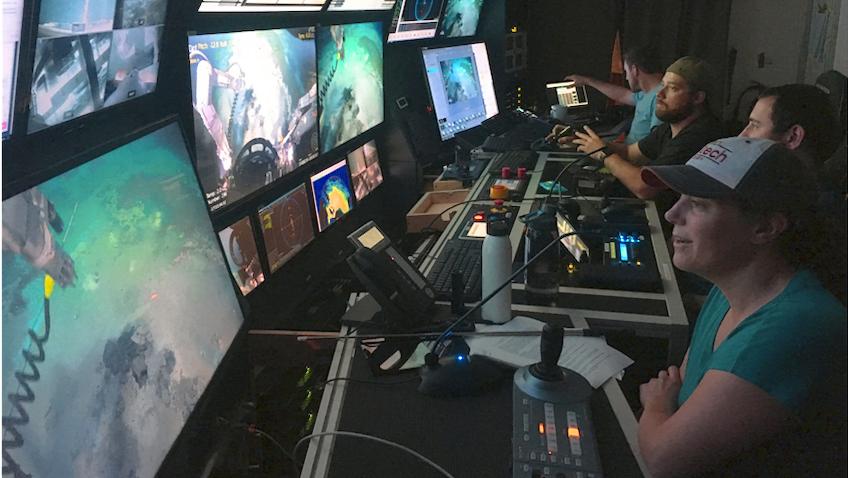Visualization Tool Helps Oceanographers Predict Sediment Sample Hotspots
Jul 11, 2024 —

A new data visualization tool designed by a Georgia Tech Ph.D. student is helping a team of microbial ecologists, geobiologists, and oceanographers gain more insight into how deep-sea microorganisms interact within their environment.
What began as an internship at NASA turned into a unique opportunity for fourth-year Ph.D. student Adam Coscia. Coscia worked under the supervision of an interdisciplinary team of collaborative researchers from Caltech, the Jet Propulsion Laboratory (JPL) Caltech manages for NASA and the ArtCenter College of Design.
Coscia’s mentors recommended him to a Caltech research team led by Victoria Orphan, a renowned microbial ecologist who studies microbial communities in the ocean and how they function within habitats in deep seafloor sediments.
Orphan and her team, the Orphan Lab at Caltech, have conducted their research since 2004. They recently decided to take a data visualization approach to record their findings and plan future expeditions.
“Historically, our data sets have been discrete and have lived in separate Excel spreadsheets,” Orphan said. “Maybe at the end, we’ll do some statistical analysis to find correlations in that data. Then we compare those to our maps. We didn’t have a way of consolidating everything under one umbrella that allows us to learn more about these ecosystems.”
Orphan said her team typically takes one or two research expeditions off the California coast annually. They spend three weeks using remotely operated vehicles (ROVs) to collect sediment samples from the ocean floor. Because time is at a premium, identifying the locations of the best samples is crucial.
Orphan is also an adjunct scientist at the Monterey Bay Aquarium Research Institute (MBARI) and works with the Seafloor Mapping Lab. The lab uses an ROV-mounted low-altitude survey system to produce detailed maps of seafloor topography.
To help the Orphan Lab work effectively with topographic and photographic data, Coscia designed DeepSee, an interactive web browser that can annotate and chart data using 3D visualization models and environmental maps.
“The idea is once you have the samples, and you’re interested in a specific area with prior samples, you can go in and annotate on the map where to collect samples next with our drawing tool,” Coscia said.
“We focused on the exploration and notetaking process with maps and data and having new ways of visualizing it. Scientists can draw and map out all their samples in real time. They can reference specific data much easier and determine where the team should go to get the best samples.”
The Orphan Lab has taken DeepSee live onboard its ship for its two most recent expeditions. Orphan has noticed an increased efficiency in expedition planning.
“The infrastructure put in place by Adam will make this an enabling tool not only for my group but for other oceanographers and scientists in other fields — anywhere there is a spatial distribution of information you want to connect to other metadata,” she said.
Orphan brings new researchers into her lab at Caltech every year, and DeepSee has accelerated the process of getting newcomers up to speed.
“We can onboard them much easier and give them a sense of what data is available and where we’ve collected information in a way that’s much clearer than having them refer to an Excel spreadsheet,” she said.
DeepSee also creates 3D data models under the sea floor using data interpolation, which estimates new data points based on the range of a set of known data points. Using the known data points, DeepSee fills in the blanks of the estimated data quality the researchers may find in nearby locations or further underneath the surface where samples were collected.
“You would never see anything visually below the sea floor,” Coscia said. “You’d have to go dig. But our 3D models show you that you might have data suggesting a hotspot just a few feet below the floor. That tells you where to sample next.”
Coscia aims to incorporate machine learning (ML) models into a future version of DeepSee that will use collected data to predict future sites for sampling. However, ML model accuracy requires significantly more data.
Coscia hopes the current version of the tool catches on so researchers can more easily incorporate machine learning into their work.
For now, the current version has plenty of uses, he said.
“Being able to organize and see your data, especially with maps, is always valuable,” he said. “My passion is helping researchers and scientists see their data in new and valuable ways.”
Coscia authored a paper on developing DeepSee, which he presented in May at the Conference on Human Factors in Computing Systems (CHI) in Honolulu, Hawaii.
Nathan Deen
Communications Officer
Georgia Tech School of Interactive Computing
nathan.deen@cc.gatech.edu




